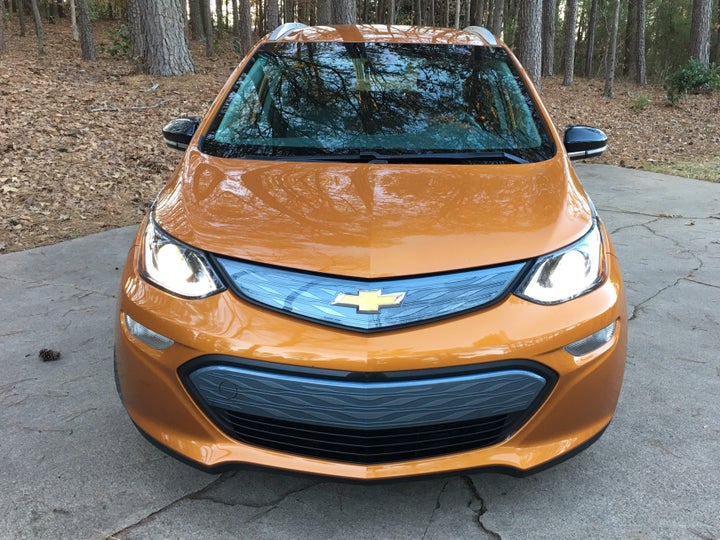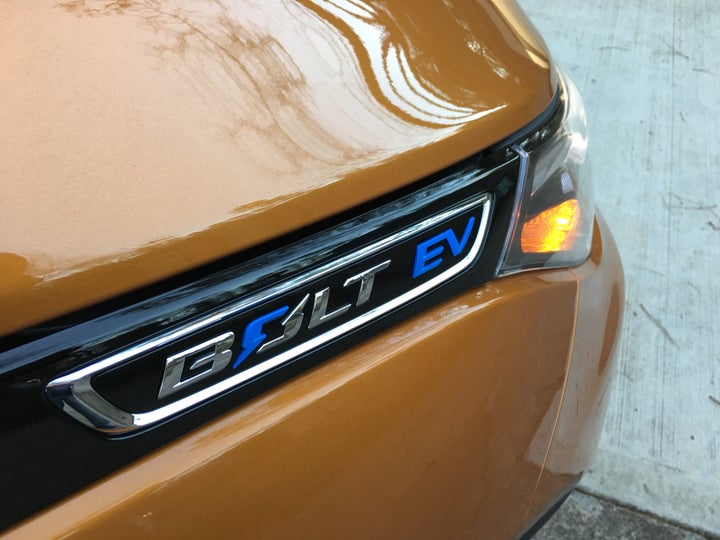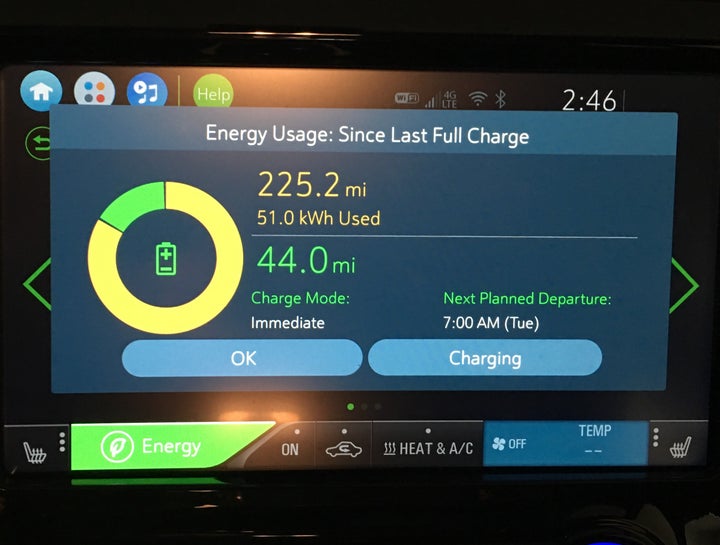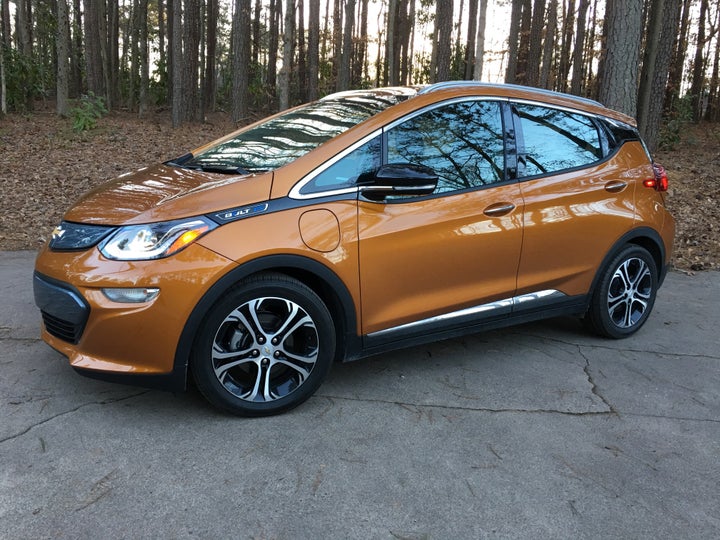
2017 Chevrolet Bolt front end
Chevrolet's big accomplishment with the new all-electric Bolt isn't the styling, the cleverly hidden "secret" cargo area, the 10.2-in touchscreen or any of the countless other little marketable things you'll likely read about in the coming year. No, Chevrolet's big accomplishment with the Bolt is the word they've eliminated from the language of affordable EVs -- worry.
The 2017 Chevrolet Bolt is an all-electric car that General Motors (GM) says will go about 238 miles on a full charge. That far exceeds any purely electric car under $60,000. Get an EV that uses gasoline or hydrogen to make that electricity and it becomes a different discussion altogether.
A Tesla Model S 60 or 60D is rated at just above 200 miles of EV range, but that car costs close to $70,000. The $43,000 BMW i3 has a range of 114 miles. The Nissan Leaf is notably less expensive, with a starting price of just over $30,000, and has a stated EV range of 107 miles. The 2017 Chevrolet Bolt is $37,495 for the base model and approaches $42,000 for the nicer Premiere version. All of these cars generally qualify for a $7,500 tax credit.

Chevrolet Bolt EV badge
Promises, Promises
The real promise of all electric cars has been the lack of burning fossil fuel (at the source of transportation) with the convenience of a typical internal combustion engine car. Yes, some of the electricity will be generated by coal, but let’s solve one problem at a time. I don’t think it’s fair to criticize Chevrolet for trying, they don’t have oversight or control over the entire power grid in the U.S. Drive an EV in places like Portland, OR and you are using all renewable resources.
Here's the good news for the Bolt. The stated range is not just smoke and mirrors. I drove 226 miles on one charge over the course of 5 days. I drove it in Atlanta, where the temperature ranged from 35 degrees overnight to 80 degrees on some days during midday. I drove on a combination of side roads and freeways, hills and valleys, and the car was driven by several other Autotrader editors during this time.
At the end of those 5 days, the charge meter said I still had 40 miles of range left. I knew the next day I had a 50-mile trip ahead of me, so I decided to plug the car in and top it off at home. A home charging cord (Level 1) comes with the car, but it really doesn't add much -- only about 4 miles of range per hour of charging.
The real headline might be: I drove an affordable EV for 5 days without plugging it in. I didn't have to get on some kind of hall-monitor-inspired wait list at work for access to free charging; I didn't have to circle the Whole Foods lot waiting for Ansley and Alcott's mommy to finish chatting, hoping a charger would open up; I didn't have to leave the car plugged in at home for 24 hours without using it. I didn't have to worry about it all -- it just works like a normal car. It works as promised.
One big reason for the lack of worry is that the mileage estimator is accurate. On some EVs, you see that you have 110 miles of range to start the day (more than enough for most daily uses), but as soon as you start driving, the range quickly drops to 80, and then 60, all within just a few actual miles of driving. The Chevy Bolt doesn't do this. One side note, using the heating or A/C takes about 10 miles of range off the in-car estimate. Most people won’t care. In other EVs, that can be a big number - the difference between 50 and 40 miles is more dramatic than the difference between 170 and 160, for example.
My weekday commute is 16 miles each way. Without driving conservatively, my trips to the office and back home are averaging about 5-9 miles of EV range used even though I'm actually traveling 16 miles. This is due to the Bolt's excellent regenerative braking system and a feature called "Regen on Demand."

Chevy Bolt energy usage screen
It's Like a Game
Nearly all EVs and hybrid cars have some kind of braking system that uses the friction caused by braking to generate electricity to add a fraction of the otherwise lost power back to the battery pack. With the Bolt, the brakes do the same, but there's also a button on the back of the steering wheel (similar to paddle shifters in sports cars) where you can hit the button and generate extra friction, adding more power to the battery.
It's not such a big deal at face value -- riding the brakes and taking extra time to come to a gentle stop will probably do the same thing in a car like, say, the Toyota Prius. What's so effective about the Bolt regen paddle is that it makes putting energy back into the battery into kind of a game.
The Chevrolet Volt has the same feature.
Bottom line, the range is real, and many people will exceed it depending on the climate and their driving habits.

2017 Chevrolet Bolt Premier in Orange Burst Metallic side view
Real Fun
But aside from all this, the Bolt is actually fun to drive -- so much that I was inventing places to go. Dairy Queen on a 40-degree night? Done. Classic-car show 20 miles up the road? I'm there. Clothes shopping at Kohl's on a Saturday afternoon? Not a chance.
Here's what makes the Bolt fun: Its electric motor generates 200 horsepower, and that means a very quick-feeling car that still has plenty of juice left to pass, even on the freeway. Most EVs feel quick off the line, but the Bolt's "Sport" button makes the car even more responsive.
Even on the freeway, the Bolt remains quiet, and it has enough weight to feel stable at highway speeds.
Now for the Bolt's minuses. For me, the front seats are too narrow. This doesn't feel like it's due to excessive bolstering from the soft seat material, like in a sports car, but it feels as if the seat frame itself is a little narrower than average. Also, the back seat is a bit of a tight fit for taller adults in terms of legroom. Shoulder room is fine, and three adults in the back seat is possible. The Bolt's rear seat is also fine for kids.
Charge It
Finally, If you're okay plugging in your EV every day or every other day, the included Level 1 charging cord is fine. However, if you like to see a full charge in your EV each day, or you just drive A LOT, you're going to want the Level 2 home charger. The Bolt's battery capacity is so large that getting a full charge from the included Level 1 charging cord might take a full day. Then again, with a 238-mile range, you likely don't need a full charge every day. A professionally installed 240-volt charger will give you about 25 miles per hour of charging. DC fast-charging capability is optional ($750) and adds 90 miles of range in roughly 30 minutes. None of this is really unique to the Bolt, it's just that psychologically, the Bolt's large battery seems slower to charge because its capacity is so large.
Bottom line -- If you've been looking for an all-electric car that doesn't cost about the same as the average American family's yearly income, the Chevrolet Bolt is for you. It's exactly what Chevy promised, minus the worry many EV owners have learned to live with.
The 2017 Chevrolet Bolt is currently available in many states like California, Oregon, Maine, Maryland and Virginia. By September of 2017, Chevrolet plans to have the Bolt EV available in all states.
